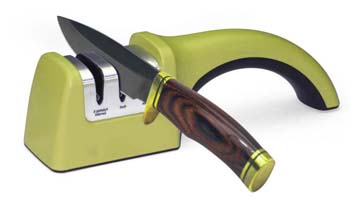Every hunter should have a reliable hunting knife. It’s mainly used to cut up the flesh and skin of the game. It’s common to experience wear and tear of the tool, as the knife-edge gets duller. However, sharpening hunting knives by hand without the right tools can be difficult and tricky. Thankfully, manufacturers have created some great knife sharpeners, that help make sure your hunting knife always stays reliable and keen. In this article, we’ll tell you about what makes the best hunting knife sharpener. You will also learn about what to look for when choosing a hunting knife sharpener that suits your specific needs. So, without further ado, let’s get started!
Top 7 Best Hunting Knife Sharpeners: Comparison Table
| Product | Grit | Sharpening Angle | Warranty | Dimensions |
| Spyderco Tri-Angle Sharpmaker with Safety Rods | Fine, medium | 30 or 40 degrees | n/a | 10 x 10 x 2 inches |
| SunrisePro Supreme Knife Sharpener | Fine | n/a | 1 year | 2.36 x 2.56 x 2.36 inches |
| Lansky Deluxe 5-Stone Sharpening System | Fine, medium, coarse | 17, 20, 25, 30 degrees | Limited lifetime | 10.25 x 9.75 x 1.5 inches |
| Work Sharp Field Sharpener | Fine (600 grit), coarse (220 grit) | 20 degrees | Limited lifetime | 6.75 x 1.5 x 1 inches |
| Sharpal 101N 6-In-1 Pocket Knife Sharpener & Survival Tool | Medium (400 grit), extra fine (1000 grit) | 20, 25, 30, 40, 50 degrees | 3 years | 8.27 x 4.72 x 0.6 inches |
| Whetstone Cutlery Knife Sharpening Stone | Medium (400 grit), extra fine (1000 grit) | n/a | n/a | 7.01 x 2.24 x 1.14 inches |
| Kershaw Ultra-Tek Blade Sharpener | Fine (600 grit) | n/a | n/a | 6 x 1 x 1 inches |
Why Is a Sharpened Hunting Knife Important?
Any knife is only useful when it’s sharp, that is obvious. Hunting knives especially must be razor-sharp, since they’re mostly used on tough material such as the skin or flesh of the game. Using a dull knife could also be dangerous, as you can accidentally cut yourself by applying too much force with the blade, causing it to slip from your hand. Cuts from dull knives are also known to take longer to heal. Many hunting knives are made of high-quality materials that are resistant to rust and other environmental factors. However, the dullness of the hunting knife is inevitable, especially if it’s used often. Whether it’s a bushcraft knife, camping knife, or hunting knife, the blade will wear down after a certain number of uses. Thus, using the best hunting knife sharpener to keep your tool keen should be a routine task.
Types of Hunting Knife Sharpeners
Whetstones
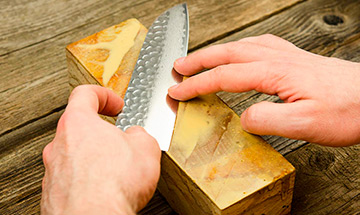
Whetstones are commonly bonded ceramics or natural material – extremely durable and can sharpen knives quickly. Before sharpening, the surface must be soaked with water or oil to lubricate the stone. The lubricant also acts to clean off the shaved metal from the surface. Whetstone sharpeners typically have two sides. One has a coarse texture while the other has a fine one, allowing you to completely hone and sharpen a hunting knife without switching materials. When sharpening with whetstones, always utilize the whole surface to keep the wear even.
Oil stones
Just like whetstones, oil stones use oil exclusively to lubricate the surface during the sharpening process. These are more durable and cheaper than whetstones but do not sharpen knives as quickly. Cleaning can also be a hassle as it may be hard to remove the oil after sharpening.
Diamond stones
Diamond stones are metal plates coated with diamond grit. These are the most durable kind and, as such, the most preferred for its hardiness. Because of this, it requires little to no maintenance. However, this type of knife sharpener is the most expensive of the bunch. Since it uses diamonds, it can even be used on other sharpening surfaces such as whetstones and oil stones, to smooth their surfaces and even out any signs of wear.
Ceramic stones
These are preferred for their heat and rust resistance and are typically used for professional sharpening. The material they’re made of is silicon carbide or alumina.
What to Look for When Buying a Hunting Knife Sharpener
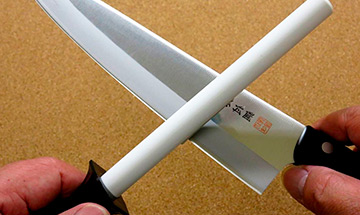
Looking for the best hunting knife sharpener is not an easy task, but some challenges can be eliminated if you know what to look for.
Sharpener Size and Weight
Hunting knife sharpeners come in many different shapes and sizes. The size can determine what kind of knife you can sharpen with it, so it’s best to opt for the size that’s right for your needs. If you plan on taking your knife sharpener on your trips, you may want something smaller and lighter so that it’s easy to lug around. However, do note that this might limit the size of hunting knives you can sharpen.
Sharpener Texture
It is important to familiarize yourself with the three kinds of textures a knife sharpener can have. These are: coarse, medium, and rough. A coarse-textured sharpener is used when a knife’s edge has been lost to damage and you need a new one. This removes the most metal and is not typically used to sharpen a blade with an already existing edge. If you just want to refine an already existing edge of the blade – a medium texture is suitable for the job. It will not remove as much metal on the blade as a coarse one, but it can make an edge very sharp. If sharpness is your biggest priority, a fine-textured sharpener will make your blade as keen as possible. This should not be used for heavy sharpening as it’s only meant to condition the edge of an already sharp blade. A fine-textured sharpener refines the blade at an atomic level, making it cut like a hot knife through butter.
Angle
The sharpness of a blade is determined by the angle at which the blade is positioned along the surface of the sharpener. Many of the best hunting knives sharpener reviews helped us understand that it’s important to keep a constant angle while sharpening. The knife’s sharpness must be constant throughout. Hunting knives are typically used for skinning animals or cutting through other tough materials like rope, bark, and branches. When it comes down to how to sharpen a hunting knife, it should be held at an angle between 20 and 30 degrees. Sharpening at less than a 20-degree angle is not recommended, as the edge could be too thin and become more prone to dulling or breaking.
| Angle | Use |
| 30° | Recommended for knives that are used for intensive work |
| 25° | Recommended for outdoor and hunting knives |
| 20° | Typically used for kitchen knives, ensures smooth cuts |
| 17° | Typically used for scalpels and razor blades, cuts that must be quick and precise |
Grit
Grit determines the size of the used abrasive material and is related to its texture. A higher grit signifies a finer surface while a smaller value denotes a coarser one. Different grits of material are used depending on the use case. When determining the suitable grit for a specific task, you can refer to this table:
| Grit | Use |
| 220 grit | Reshaping or repairing a blade |
| 300 grit | Refining a dull knife |
| 1000 grit | Common use-cases and typical for basic sharpening stones |
| 1200 grit | Sharpening traditional Japanese knives |
| 6000 grit | Finishing edges |
| 8000 grit | Ultra-fine finishing for an extremely sharp and polished blade |
The Shape of Your Blade
Some knife sharpeners, especially electric ones, only work with certain blade shapes and sizes. A smaller sharpener is more portable but has a limited surface area – not good for bigger blades. Meanwhile, larger sharpeners give you more space but are bulkier and heavier.
Manual Vs Electric Hunting Knife Sharpener: Which Is Better?
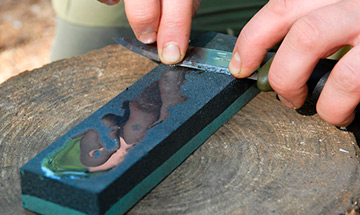
When choosing a knife sharpener, one of the most important aspects to consider is whether you should get a manual or electric one. It’s not always an easy choice. A manual knife sharpener gives you finer control in terms of speed and pressure. This is not as easy to do with electric sharpeners, as those can be a bit too aggressive. While manual sharpeners will require more work and skill, they’re smaller which makes them easy to store and bring around on hunting trips. These are perfect for hunters who are always on the move and are meticulous when it comes to the quality of their knife blades. On the other hand, electric sharpeners are automated and efficient at their job. Electric knife sharpeners are special in that they require very little effort to use and sharpen blades very quickly. Some even give users an option to set their desired sharpening angle, which is a function that is often praised in many hunting knife sharpener reviews. The type of hunting knife sharpener you choose depends entirely on your needs. If you have a lot of knives to sharpen and need consistency, you should probably go for an electric sharpener. However, if you need finer control and portability, a manual sharpener might be for you. The best hunting knife sharpener is the one that can easily satisfy all your needs and matches your preferences.
Knife Sharpening Tips
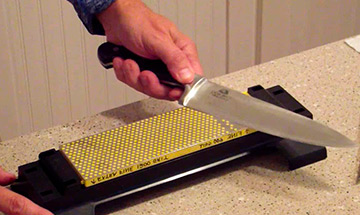
Keeping your hunting knife in top condition won’t be that difficult if you’re willing to put in a little bit of work. After choosing your most preferred or the best knife sharpener for hunting knives, you’ll need to practice your skills and take the necessary measures to make sure your knife doesn’t wear down too quickly.
- Before sharpening, make sure that the blade has been cleaned and dried. This is because any gunk on the edge may obstruct the sharpening process.
- Go over the guidelines from the manufacturer to ensure that you use the sharpener as instructed. This will not only get you the best results but will also help you avoid damaging both your knife and sharpener.
- If you’ll be using a stone sharpener, avoid adding too much pressure onto the blade as it may get chipped or even break. Move the blade in a single, constant motion against the sharpener until you get your desired edge.
- You will typically only need to sharpen your hunting knife once every one or two months if it’s used regularly. Alternatively, you may need to sharpen it once you start to feel a bit of resistance when you try cutting through a thin sheet of paper.
Conclusion
And that’s all for now! We worked with a lot of information, to bring you our own article about the best hunting knife sharpener 2023! With that said, we hope that this article was useful and helped you learn how you can keep your trusty ol’ hunting knife in the best condition. As Emmer Wolf once said, “A man is only as good as his tools.” So, be sure to take care of your equipment so you can make the most out of your hunting trips!

